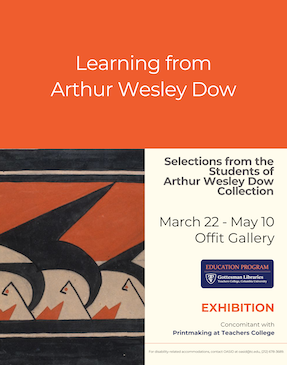New Exhibit: Learning from Arthur Wesley Dow
Offit Gallery
The Students of Arthur Wesley Dow Collection contains 300 works created by Teachers College students studying under Professor Arthur Wesley Dow in the early 1900s. Mostly paintings and prints, the works in the collection clearly illustrate Dow's theories and approach to art. Shown in this exhibit are select works in different mediums that demonstrate composition, the “putting together” of lines, masses, and colors to build harmony, a fundamental process in the fine arts. Wood engraving; wood block prints; collage; ink, charcoal, pastel, pencil, poster color paint on paper and/or tissue are mediums through which Dow’s students, including Albert Heckman, Lucile Raston, and Lynd Ward, exercised studio learning in Macy Hall of Teachers College.
About Arthur Wesley Dow
Arthur Wesley Dow (born April 6, 1857, Ipswich, Massachusetts, - died December 13, 1922, New York, New York) was an influential American painter, printmaker, photographer, and educator, recognized for his progressive teachings based on Japanese principles of art and his significant artistic and intellectual contributions to the Arts and Crafts movement. In 1900, Dow founded and served as the director of the Ipswich Summer School of Art in Ipswich, Massachusetts. From 1896-1003 he taught at Pratt Institute, from 1898-1898, at the New York Art Students League. From 1904-1922, Dow served as Professor of Fine Arts and Head of the Department of Fine Arts, at Teachers College, Columbia University where he was beloved by his students.
In his teachings, Dow emphasized the importance of carefully executing each and every step of the artistic process, from design to printing. Published in 1899, his seminal text, Composition: A Series of Exercises in Art Structure for the Use of Students and Teachers saw more than 20 printings over 40 years, a renowned textbook in use for decades. In it, he described the three main elements of art: line, notan (the Japanese concept of light and shade, or mass), and color. For principles of composition and ways of creating harmony, he illuminated opposition, transition, subordination, repetition, and symmetry.
Dow encouraged his students, including Georgia O’Keeffe and her sister, Ida, to be inspired by nature, looking to landscape and flowers, for example, when seeking examples of good design. He taught generations of significant artist teachers, among them, Albert Heckman, Charles Martin, Arthur Young, and Sallie Tannahill. Even as the Department of Fine Arts grew “modern” under the teachings of other great artist-teachers, like Federico Castellon, Edwin Ziegfeld, and Victor D’Amico, the fundamental teachings of Dow in art and art education remained.
Acknowledgements
Learning from Arthur Wesley Dow: Selections from the Students of Arthur Wesley Dow Collection is made possible through the generous support of The Myers Foundations. The exhibit is curated and designed by Soeun Bae, Library Associate for Art and Design, in collaboration with Jennifer Govan, Library Director and Senior Librarian.
Where: Offit Gallery
When: March 22nd - May 10th

Poster Image: Untitled, 5, n.d., from the Students of Arthur Wesley Dow Collection, Courtesy of Teachers College, Columbia University.

